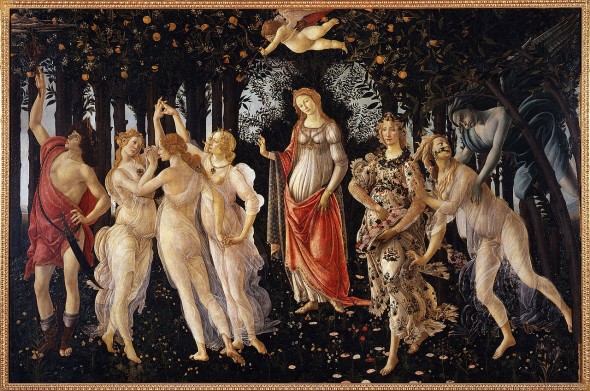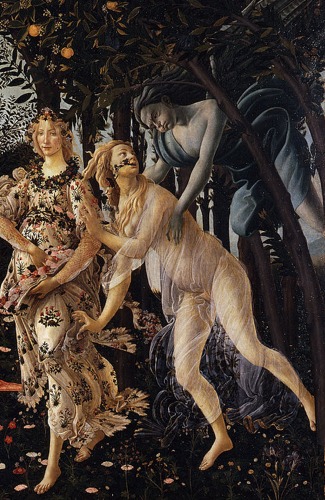Three Art Principals Used in the Beech Grove I

Sandro Botticelli, La Primavera, c. 1482, tempera on wood
Sandro Botticelli was one of the nearly well-known of the Medici employees. He studied under Fra Filippo Lippi and had a technique which focused on line, and his forms were lightly shaded. While art historians consider Botticelli to have been an proficient at using line, he was also adept at using color.

The scene shows u.s. a grouping of figures in an orange grove. One of the first things we should note is that little is used in terms of perspective; while some atmospheric perspective is visible through the trees to the right and to the left, we do non see the 1-point linear perspective here which some of the early Renaissance masters had used and so effectively in the fifteenth century. As well, annotation how nearly of the figures accept limbs which are long and slender and appear rather elegant. Botticelli produced art at a time when there was a demand in the court of Florence for this blazon of work.
While the exact pregnant of the painting eludes united states of america, we do know the identities of many of the figures who are shown in information technology. In the heart is the Roman goddess, Venus. Her presence is a reflection of the humanist involvement in the classical globe which was popular in Florence at this time. She is depicted as an idealized adult female, slightly off-heart, with her caput tilted and gesturing to her right. Above her is a blindfolded cupid (her son), and backside him the tree limbs form an arch which conveniently frame Venus and provide her with a privileged position in the painting
To the far left, Mercury, the god of the month of May, has a staff which he may be using to conductor abroad the winter clouds. He is readily identifiable by his prominent winged sandals.
To the right of Mercury is an of import group called the Three Graces. These women, who appear to exist involved in some blazon of dance, were modeled by Botticelli after an ancient depiction of the Iii Graces. These figures are important because they represent the feminine virtues of Chastity, Beauty, Love, all of which point to romance and provide us with some context in terms of what is going on in the painting. The Roman writer Seneca refers to them every bit "pure and undefiled and holy in the eyes of all", and we can see the pearls on their heads which symbolize this blazon of purity. Their clothing is similar lace, very light, and see-through, which demonstrates Botticelli's virtuosity in depicting such kinds of textile. It is interesting to see that they are being targeted by Cupid's arrow, which reinforce the thought of marriage.

Taking the scene as a whole, information technology is probably best understood in low-cal of an emblematic pregnant. The allusions to Leap and the month of May, the scene of a suitor's pursuit, the Three Graces – all of these point to the idea of a springtime marriage. The setting in an orangish grove is besides noteworthy, since the Medici had adopted the orangish tree every bit its family symbol. The painting would have been placed in Lorenzo di Pierfrancesco'south bedroom and his wife would accept seen it for the first time later on their wedding, so the idea of Cupid targeting the pure Three Graces with his arrow takes on a item meaning in light of bridal love. In whatever instance, the painting is a attestation to humanist interests in classical subject area matter in the Renaissance, besides as the ladylike desire for lavish themes and graceful figures.
Source: http://www.italianrenaissance.org/a-closer-look-botticellis-primavera/
0 Response to "Three Art Principals Used in the Beech Grove I"
Post a Comment